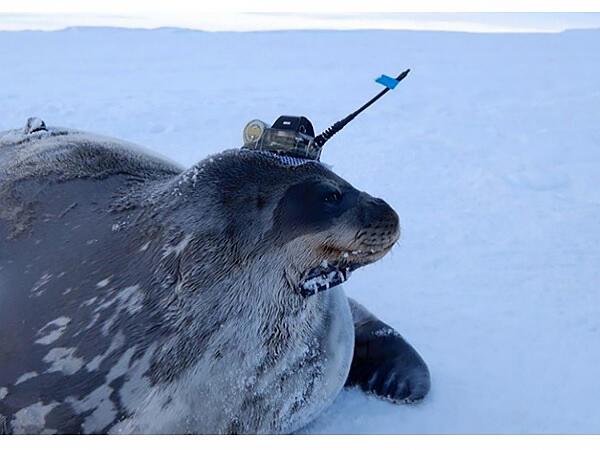Using a water temperature and salinity recorder, it was revealed that warm seawater (warm water) was flowing from the surface of the open ocean to the coast of Antarctica in autumn. Further, it was revealed that the seals were using the warm water for efficient feeding. The research conducted as part of the 58th Japanese Antarctic Research Expedition (2016-18) by the group led by Nobuo Kokubun (Assistant Professor, National Institute of Polar Research) will help to clarify the mechanism of ocean circulation along the Antarctic coast from autumn to winter and the response of marine ecosystems.
The mysterious habitat of large sea animals
Many large animals such as penguins and seals can survive on the Antarctic coast because of the high biological production associated with the influx of nutrient-rich warm water from the deep ocean. However, such phenomena were observed only in marine areas with deep submarine canyons and ocean vortices, where deep water from the open ocean could easily flow in, and in marine areas with wide continental shelves. Further, on the coast of Antarctica, there is a large marine area of fast ice, which is covered with sea ice that does not move easily and is attached to the land; several large animals can be observed in this area as well. However, ship-based oceanographic surveys were logistically difficult to conduct due to the thick ice, and the mechanism by which the large animals in this area survived was not well understood.
A recorder attached to the head
To investigate further, the research team attached a conductivity, temperature, and depth (CTD) tag to the head of Weddell seals that lived near Showa Station in Antarctica and recorded the previously unknown coastal marine environment from autumn to winter. The CTD tag weighs 580 grams, which is light when compared to the seal's body weight (326 kilograms on average). Therefore, the load on the animal is small, and it falls off with the seal's hair during shedding.
From autumn (March-April) to spring (September) of 2017, CTD tags were attached to eight animals, and data was obtained from seven animals for up to about eight months. The autumn-winter water temperature and salinity data obtained were analyzed. Similar to previous findings, low-temperature water with low salinity was observed throughout the area under observation during the observation period. By contrast, high-temperature water with high salinity was observed at greater depths in limited areas, such as deep submarine canyons, from autumn to winter. Meanwhile, it was revealed for the first time that warm water with low salinity was present at many points along the coast at shallow depths (100-150 meters) in the fall, sinking up to 400 meters as the season progressed. In addition, the research group determined an index showing how efficiently the seals were feeding based on records of the diving depths of the seals and analyzed how the type of seawater affected the feeding behavior. Results revealed that the seals were feeding more efficiently in water with high temperature and low salinity as well as in water with high temperature and high salinity than in water with low temperature and low salinity.

(Photo: National Institute of Polar Research)
Influence of other species such as krill
The research group further investigated the origin of this high-temperature, low-salinity water in detail based on model calculations using wind direction and speed. Results of the analysis suggested that the stronger winds blowing westward along the coast in autumn strengthened the flow from the open sea to the coast on the surface layer and that some of the seawater experienced a particularly strong force that sank it downward. The warm waters of the open ocean surrounding the Antarctic coast are home to important prey species for higher predators, such as Antarctic krill. It is possible that the Weddell seal, which lives along the coast, feeds more efficiently as a result of such prey organisms being carried to the coast by the force of the wind from the open ocean during the fall season.
This study demonstrates, for the first time, the possibility that seawater and prey organisms are brought from the surface layer of the open ocean to the coastal area of Antarctica by the force of the wind, which strengthens in the autumn season. The research group hopes to combine the results of this survey with model calculations to estimate the amount of seawater and prey carried to the continental shelf by the force of the wind.
This article has been translated by JST with permission from The Science News Ltd.(https://sci-news.co.jp/). Unauthorized reproduction of the article and photographs is prohibited.




